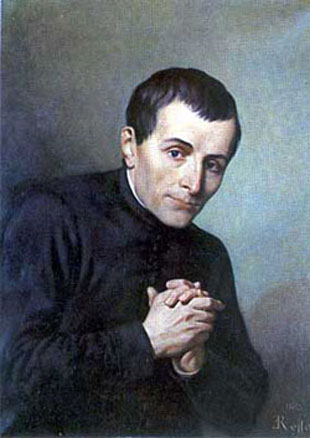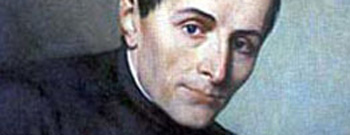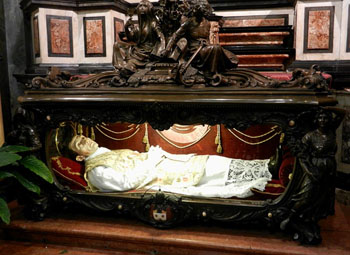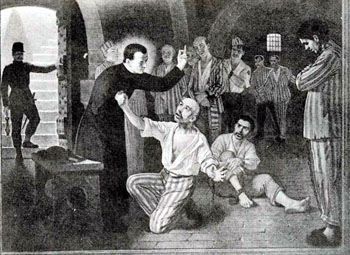The Saint of the Day
 |
 |
 |
 |
 |
 |
 |
St. Joseph Cafasso - June 23
This is a picture of St. Joseph Cafasso (1811-1860).
 I have the impression that he has a temperament ready to ignite into fire. That fire is allied so strongly to love – conceived by the intelligence and exercised by the will – that it has penetrated and completely conquered his eyes. Although the rest of his physiognomy is very expressive, his eyes dominate.
I have the impression that he has a temperament ready to ignite into fire. That fire is allied so strongly to love – conceived by the intelligence and exercised by the will – that it has penetrated and completely conquered his eyes. Although the rest of his physiognomy is very expressive, his eyes dominate.
After seeing this picture, is it possible to discuss his nose, mouth, ear or any other feature? No, he is only his eyes. The impression that we have is not a “marriage” of the spirit with the body, but the opposite: He has a spirit that burns so intensely that it consumes the body. The presence of his soul is so intense that he almost does not realize that he has a body.
We can imagine another Saint lying down on a bed and resting like an Angel in the peace of the Lord. St. Joseph Cafasso is the same whether seated, kneeling or lying down – he is always this burning figure with expressive eyes. We have the impression that even when he slept his closed eyes continued to emit this fire.
He is extraordinary! He is a colossus of seriousness. More than in the blackness of his eyes, his seriousness is expressed in something profoundly investigative, interrogative and analytic. It is an analytic gaze that moves forward, constantly conquering and dominating. He has the criteria for analysis, the tools for analysis, and he knows is not worthwhile to pay attention to petty things.
If he were passing through a street and saw two dogs running, one chasing the other, he would pay no attention to the scene or see it as a symbol of something else. If there were not something transcendent in it, he would disregard it.
This fire and flame is something truly admirable!
 His gaze is deeply linked to an act of will. His analysis comes not only from the penetration of the intelligence but also from a firmness. It is not only firmness but that agrede [aggressiveness], which St. Thomas discusses. Although he was never a Crusader, but a man who made charitable works, we can see that if he were given the task to convene a Crusade, he would have that fiery eloquence which moves the masses.
His gaze is deeply linked to an act of will. His analysis comes not only from the penetration of the intelligence but also from a firmness. It is not only firmness but that agrede [aggressiveness], which St. Thomas discusses. Although he was never a Crusader, but a man who made charitable works, we can see that if he were given the task to convene a Crusade, he would have that fiery eloquence which moves the masses.
You may have noticed that there is an underlying sadness in his gaze. It is a very pacific sadness in the sense that his soul is in peace. It is a sadness that asks: “Even you? Even you have sinned in this way and reached this point?” His whole person seems to say: “I already know that human wickedness has no end. As far as the human gaze can see, there is no bottom. It is an abyss so deep that the human gaze cannot fanthom it. What a horror!”
He is a man deeply conscious of the fact that we cannot find true joy or delight in this life. He is fully convinced that it is an illusion to consider the world as good. For him the only true reality is to disregard the world as nothing and to wait for Heaven. The failure of the world to give happiness makes the existence of Heaven necessary.
The depth of this soul reveals the contrast between the high idea of how things should be, how the model ideals are, how the celestial order is and, finally, how the reality he has before his eyes is. From these lofty criteria comes the lucidity of his analysis, the firmness of his fidelity, the energy of his rejection and the fire of his soul!
 Who would want to be caught whispering some filthy suggestions in his ear to degrade this soul by inducing such a man to sin? What remorse would such a foolish person have for doing this! The one who would make such suggestions would be repeating the treason of Judas, because he would be selling Our Lord present in this soul in order to pervert it.
Who would want to be caught whispering some filthy suggestions in his ear to degrade this soul by inducing such a man to sin? What remorse would such a foolish person have for doing this! The one who would make such suggestions would be repeating the treason of Judas, because he would be selling Our Lord present in this soul in order to pervert it.
From here you understand by contraries how this soul is beautiful. If to degrade it would cause such affliction, how great the joy one would have who were to cooperate in sanctifying it! How great the joy to realize what this soul is even if we did not contribute to its sanctification!
How much thirst for this soul! What do we mean by thirst here? It is the ardent desire that one should be as it is in order to belong to God in this way. It is the desire that he would condescend to come down from Heaven and help each one of us. This is the thirst for souls.
Note: Joseph Cafasso was born at Castelnuovo d'Asti in the Piedmont, Italy, of peasant parents. He studied at the Seminary at Turin, and was ordained in 1833. He continued his theological studies at the Seminary and University at Turin and then at the Institute of St. Franics, and despite a deformed spine, became a brilliant lecturer in Moral Theology there.
 He was a popular teacher, actively opposed Jansenism, and fought State intrusion into Church affairs. He succeeded Luigi Guala as Rector of the Institute in 1848 and made a deep impression on his young priest students with his holiness and insistence on discipline and high standards. He was a sought-after confessor and spiritual adviser, and ministered to prisoners, working to improve their poor conditions.
He was a popular teacher, actively opposed Jansenism, and fought State intrusion into Church affairs. He succeeded Luigi Guala as Rector of the Institute in 1848 and made a deep impression on his young priest students with his holiness and insistence on discipline and high standards. He was a sought-after confessor and spiritual adviser, and ministered to prisoners, working to improve their poor conditions.
He met Don Bosco in 1827 and the two became close friends. It was through Joseph’s encouragement that John Bosco decided his vocation was working with boys. Joseph was his adviser, worked closely with him in his foundations, and convinced others to fund and found religious institutes and charitable organizations. Joseph died on June 23 at Turin and was canonized in 1947.


The Saint of the Day features highlights from the lives of saints based on comments made by the late Prof. Plinio Corrêa de Oliveira. Following the example of St. John Bosco who used to make similar talks for the boys of his College, each evening it was Prof. Plinio’s custom to make a short commentary on the lives of the next day’s saint in a meeting for youth in order to encourage them in the practice of virtue and love for the Catholic Church. TIA thought that its readers could profit from these valuable commentaries.
The texts of both the biographical data and the comments come from personal notes taken by Atila S. Guimarães from 1964 to 1995. Given the fact that the source is a personal notebook, it is possible that at times the biographic notes transcribed here will not rigorously follow the original text read by Prof. Plinio. The commentaries have also been adapted and translated for TIA’s site.

St. Giuseppe Cafasso
After seeing this picture, is it possible to discuss his nose, mouth, ear or any other feature? No, he is only his eyes. The impression that we have is not a “marriage” of the spirit with the body, but the opposite: He has a spirit that burns so intensely that it consumes the body. The presence of his soul is so intense that he almost does not realize that he has a body.
We can imagine another Saint lying down on a bed and resting like an Angel in the peace of the Lord. St. Joseph Cafasso is the same whether seated, kneeling or lying down – he is always this burning figure with expressive eyes. We have the impression that even when he slept his closed eyes continued to emit this fire.
He is extraordinary! He is a colossus of seriousness. More than in the blackness of his eyes, his seriousness is expressed in something profoundly investigative, interrogative and analytic. It is an analytic gaze that moves forward, constantly conquering and dominating. He has the criteria for analysis, the tools for analysis, and he knows is not worthwhile to pay attention to petty things.
If he were passing through a street and saw two dogs running, one chasing the other, he would pay no attention to the scene or see it as a symbol of something else. If there were not something transcendent in it, he would disregard it.
This fire and flame is something truly admirable!

A gaze that reveals a strong will
You may have noticed that there is an underlying sadness in his gaze. It is a very pacific sadness in the sense that his soul is in peace. It is a sadness that asks: “Even you? Even you have sinned in this way and reached this point?” His whole person seems to say: “I already know that human wickedness has no end. As far as the human gaze can see, there is no bottom. It is an abyss so deep that the human gaze cannot fanthom it. What a horror!”
He is a man deeply conscious of the fact that we cannot find true joy or delight in this life. He is fully convinced that it is an illusion to consider the world as good. For him the only true reality is to disregard the world as nothing and to wait for Heaven. The failure of the world to give happiness makes the existence of Heaven necessary.
The depth of this soul reveals the contrast between the high idea of how things should be, how the model ideals are, how the celestial order is and, finally, how the reality he has before his eyes is. From these lofty criteria comes the lucidity of his analysis, the firmness of his fidelity, the energy of his rejection and the fire of his soul!

His tomb in the Santuario della Consolata,
the college he founded
From here you understand by contraries how this soul is beautiful. If to degrade it would cause such affliction, how great the joy one would have who were to cooperate in sanctifying it! How great the joy to realize what this soul is even if we did not contribute to its sanctification!
How much thirst for this soul! What do we mean by thirst here? It is the ardent desire that one should be as it is in order to belong to God in this way. It is the desire that he would condescend to come down from Heaven and help each one of us. This is the thirst for souls.
Note: Joseph Cafasso was born at Castelnuovo d'Asti in the Piedmont, Italy, of peasant parents. He studied at the Seminary at Turin, and was ordained in 1833. He continued his theological studies at the Seminary and University at Turin and then at the Institute of St. Franics, and despite a deformed spine, became a brilliant lecturer in Moral Theology there.

He was famous in his own time for his work with hardened prisoners his fight against Jansenism
He met Don Bosco in 1827 and the two became close friends. It was through Joseph’s encouragement that John Bosco decided his vocation was working with boys. Joseph was his adviser, worked closely with him in his foundations, and convinced others to fund and found religious institutes and charitable organizations. Joseph died on June 23 at Turin and was canonized in 1947.

 | |
|
|
The texts of both the biographical data and the comments come from personal notes taken by Atila S. Guimarães from 1964 to 1995. Given the fact that the source is a personal notebook, it is possible that at times the biographic notes transcribed here will not rigorously follow the original text read by Prof. Plinio. The commentaries have also been adapted and translated for TIA’s site.


